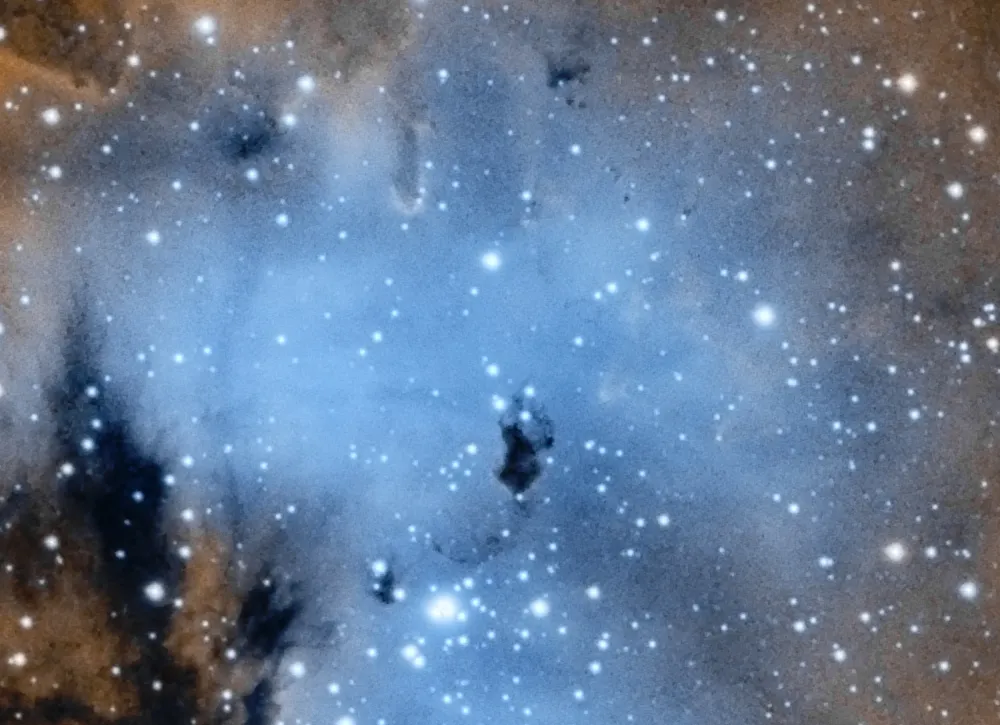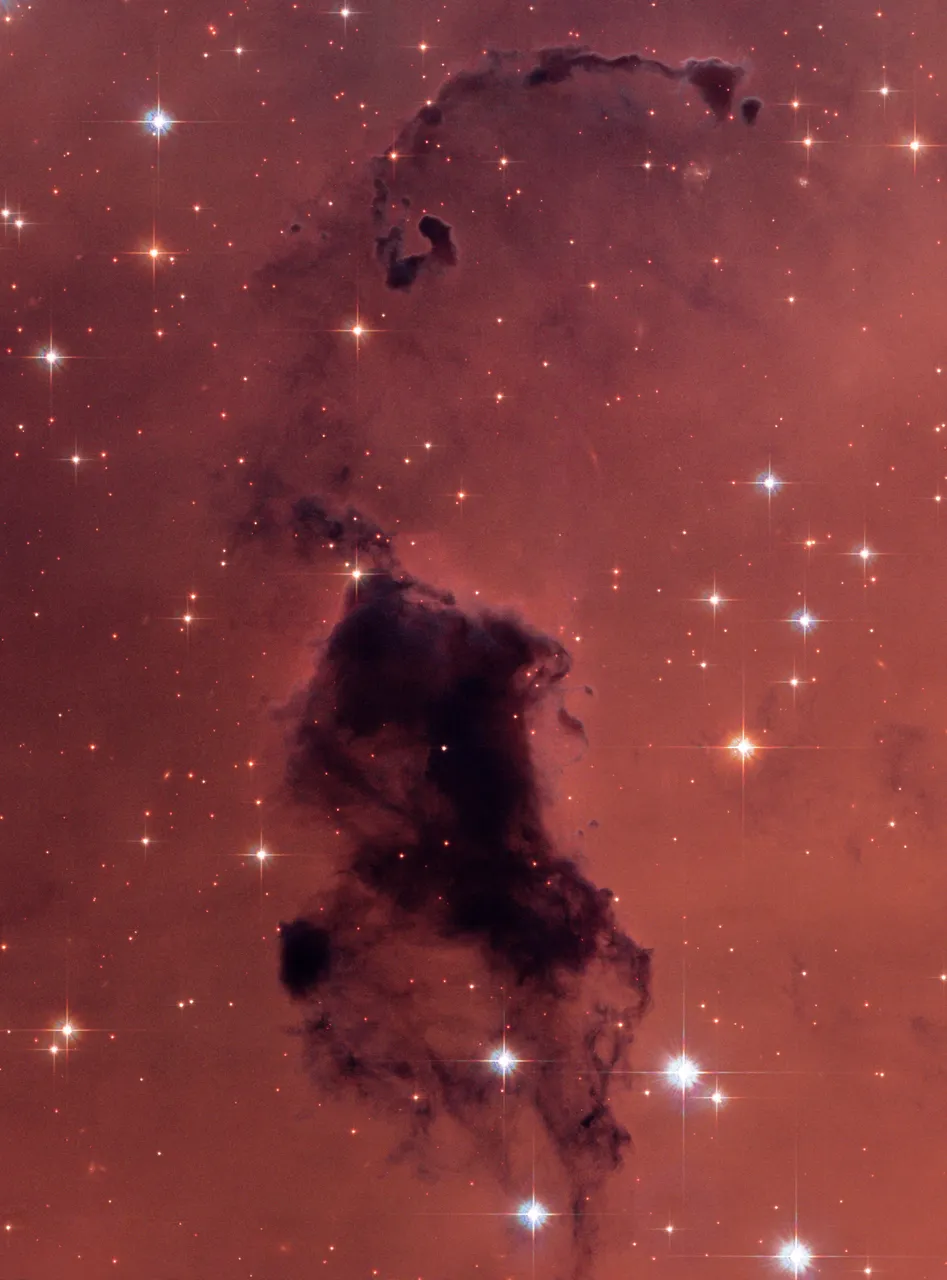The Pacman Nebula (NGC281) is a small Emission Nebula, which can be found at a distance of around 9,500 light-years away from us in the constellation of Cassiopeia.
In the center of the Pacman Nebula is the Open Cluster IC1590. The brightest star of this cluster, the star HD5005, is the star that ionizes the gases in the nebula and thus causes them to shine in their specific wavelengths.
The Pacman Nebula also contains some Bok Globules. One of those is almost right in the center of the nebula, a little bit above the Open Cluster IC1590.
The Pacman Nebula captured with a focal length of 420mm and stacked with a 2x drizzle. Due to the drizzle, the shown scale corresponds to about 840mm focal length.

Click on the image for a larger view ▲
Bok Globules are dense, gas- and dust-rich parts of molecular clouds in which star formation occurs. The gases inside a Bok Globule first compress into protostars and then further and further until the Protostars are finally hot enough to ignite nuclear fusion... A new star is born.
Some of the most well known Bok Globules are the star-forming regions inside the Orion Nebula and the Eagle Nebula.
Some of the Bok Globules in the center of the Pacman Nebula. This is a 100% crop of the above image.

Click on the image for a larger view ▲
Because I am a little bit limited with my small earthbound telescope, here is a picture of the central Bok Globule taken with the Hubble Space Telescope.
Original title: Bok Globules in the NGC 281 Nebula (IC 1590 Cluster).

Copyright: public domain, NASA, ESA, and The Hubble Heritage Team (STScI/AURA)
The resolution is "slightly" better than in my picture. I think the details can be seen very well, even if the Hubble Space Telescope image is rotated by 180 degrees.
Maybe you also notice the difference in color? This is because the Hubble hydrogen-emission (H-alpha, ionized hydrogen) image was combined with Hubble images taken in red, green, and blue to show the real color of the stars.
My picture was taken with a filter for the wavelengths of hydrogen-emission (H-alpha, ionized hydrogen) and oxygen-emission (OIII, ionized oxygen). The colors were not assigned to their natural wavelengths; instead, they are mapped according to the so-called Hubble Palette. This color mapping technic assigns the images taken in the hydrogen-emission (H-alpha, ionized hydrogen) wavelength to the green, the oxygen-emission (OIII, ionized oxygen) wavelength to the blue, and the sulfur-emission (SII, ionized sulfur) wavelength to the red channel. As my filter only has a pass-through for the H-alpha and the OIII image data wavelengths, I had to generate the data for the red channel synthetic. It is a mix of the H-alpha and the OIII image data.
Position in the night sky
As mentioned above, the Pacman Nebula (NGC2181) is part of the constellation Cassiopeia. Cassiopeia can be easily found due to the brightest stars that are aligned as a big W.
Position of the Pacman Nebula in the night sky. Screenshot of SkySafari Pro app for iOS.

Click on the image for a larger view ▲
Details of the image
The picture was taken in my Backyard with the following equipment and settings.
| Camera |
QHYCCD247C |
| Telescope |
TSAPO65Q · 420mm · f6.5 |
| Filter |
STC Duo-Narrowband Filter (48mm / 2") |
| Guide camera |
QHY5L-II |
| Guide scope |
TSL60D · 240mm · f4.0 |
| Mount |
Skywatcher AZ EQ-6 |
| Exposure time |
90 x 300" = 450 minutes = 7 hours 30 minutes |
| ISO |
Unity Gain @ -20°C |
Everything is controlled by my Astro-PC via remote desktop and wireless LAN.
Software: Sequence Generator Pro, PixInsight, Photoshop CC
The license of my pictures
All images, otherwise clearly indicated, in this post are my own work.
You can use it for free if you credit them to @astrophoto.kevin.
 Attribution-ShareAlike 4.0 International (CC BY-SA 4.0)
Attribution-ShareAlike 4.0 International (CC BY-SA 4.0)
References
https://de.wikipedia.org/wiki/NGC_281
https://hubblesite.org/contents/news-releases/2006/news-2006-13.html
https://de.wikipedia.org/wiki/Globule
https://www.universeguide.com/star/hip4121
http://hubble.stsci.edu/gallery/behind_the_pictures/meaning_of_color/eagle.php
Thank you very much for visiting and reading!
If you have any questions or suggestions, please don’t be afraid to let me know of anything you thought about this post in the comments below!
Yours, @astrophoto.kevin
I wish a Merry Christmas and a Happy New Year to all of you!
Enjoy the holidays, and start healthy into the new year!

SteemSTEM is a community project with the goal to promote and support Science, Technology, Engineering and Mathematics on the Steem blockchain. If you wish to support the steemSTEM project you can:
Contribute STEM content using the #steemstem tag | Support steemstem authors | Join our curation trail | Visit our Discord community | Delegate SP to steemstem
Convenient Delegation Links:
50 SP | 100SP | 500SP | 1,000SP | 5,000SP | 10,000SP | 50,000SP
The Pacman Nebula (NGC281) is a small Emission Nebula, which can be found at a distance of around 9,500 light-years away from us in the constellation of Cassiopeia.
In the center of the Pacman Nebula is the Open Cluster IC1590. The brightest star of this cluster, the star HD5005, is the star that ionizes the gases in the nebula and thus causes them to shine in their specific wavelengths.
The Pacman Nebula also contains some Bok Globules. One of those is almost right in the center of the nebula, a little bit above the Open Cluster IC1590.
The Pacman Nebula captured with a focal length of 420mm and stacked with a 2x drizzle. Due to the drizzle, the shown scale corresponds to about 840mm focal length.
Click on the image for a larger view ▲
Bok Globules are dense, gas- and dust-rich parts of molecular clouds in which star formation occurs. The gases inside a Bok Globule first compress into protostars and then further and further until the Protostars are finally hot enough to ignite nuclear fusion... A new star is born.
Some of the most well known Bok Globules are the star-forming regions inside the Orion Nebula and the Eagle Nebula.
Some of the Bok Globules in the center of the Pacman Nebula. This is a 100% crop of the above image.
Click on the image for a larger view ▲
Because I am a little bit limited with my small earthbound telescope, here is a picture of the central Bok Globule taken with the Hubble Space Telescope.
Original title: Bok Globules in the NGC 281 Nebula (IC 1590 Cluster).
Copyright: public domain, NASA, ESA, and The Hubble Heritage Team (STScI/AURA)
The resolution is "slightly" better than in my picture. I think the details can be seen very well, even if the Hubble Space Telescope image is rotated by 180 degrees.
Maybe you also notice the difference in color? This is because the Hubble hydrogen-emission (H-alpha, ionized hydrogen) image was combined with Hubble images taken in red, green, and blue to show the real color of the stars.
My picture was taken with a filter for the wavelengths of hydrogen-emission (H-alpha, ionized hydrogen) and oxygen-emission (OIII, ionized oxygen). The colors were not assigned to their natural wavelengths; instead, they are mapped according to the so-called Hubble Palette. This color mapping technic assigns the images taken in the hydrogen-emission (H-alpha, ionized hydrogen) wavelength to the green, the oxygen-emission (OIII, ionized oxygen) wavelength to the blue, and the sulfur-emission (SII, ionized sulfur) wavelength to the red channel. As my filter only has a pass-through for the H-alpha and the OIII image data wavelengths, I had to generate the data for the red channel synthetic. It is a mix of the H-alpha and the OIII image data.
Position in the night sky
As mentioned above, the Pacman Nebula (NGC2181) is part of the constellation Cassiopeia. Cassiopeia can be easily found due to the brightest stars that are aligned as a big W.
Position of the Pacman Nebula in the night sky. Screenshot of SkySafari Pro app for iOS.
Click on the image for a larger view ▲
Details of the image
The picture was taken in my Backyard with the following equipment and settings.
Everything is controlled by my Astro-PC via remote desktop and wireless LAN.
Software: Sequence Generator Pro, PixInsight, Photoshop CC
The license of my pictures
All images, otherwise clearly indicated, in this post are my own work.
You can use it for free if you credit them to @astrophoto.kevin.
References
https://de.wikipedia.org/wiki/NGC_281
https://hubblesite.org/contents/news-releases/2006/news-2006-13.html
https://de.wikipedia.org/wiki/Globule
https://www.universeguide.com/star/hip4121
http://hubble.stsci.edu/gallery/behind_the_pictures/meaning_of_color/eagle.php
Thank you very much for visiting and reading!
If you have any questions or suggestions, please don’t be afraid to let me know of anything you thought about this post in the comments below!
Yours, @astrophoto.kevin
I wish a Merry Christmas and a Happy New Year to all of you!
Enjoy the holidays, and start healthy into the new year!
SteemSTEM is a community project with the goal to promote and support Science, Technology, Engineering and Mathematics on the Steem blockchain. If you wish to support the steemSTEM project you can:
Contribute STEM content using the #steemstem tag | Support steemstem authors | Join our curation trail | Visit our Discord community | Delegate SP to steemstem